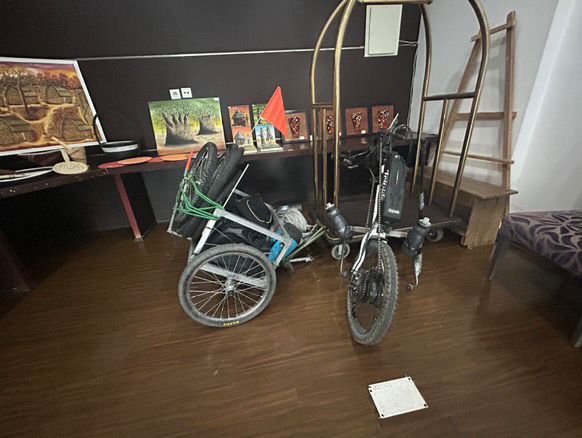Setting out to complete a monumental challenge takes a considerable amount of guts, determination, and often sheer doggedness to see through what it is that you aim to achieve. This approach to life, this refusal to concede that you may have bitten off more than you can chew, is nowhere more evident than when witnessing the feats that Schwan Wahab is currently striving to achieve as he attempts to become the first person in history to travel around the entire African continent in a wheelchair.
Originally from Iraq, Schwan moved to Switzerland aged 12, after losing both of his legs in a war-related accident. Now, aged 28, and with little more than a handbike adaption for the front of his chair, and a homemade trailer cart to his supplies, attached to the back of his chair, Schwan has already traversed Botswana, Namibia, and Zimbabwe on his mission. Schwan films his adventures with a camera mounted to the front of his cycle rig and you can follow along via his Instagram account exploringability and his various other social media platforms, including YouTube (linked at the end of the interview).
I recently had the pleasure of chatting with Schwan and asked him a few questions about his journey so far and to get the perspective of a disabled traveler’s experiences in Africa. What follows is the interview from our conversation.
1. How are you feeling at this point in the journey? You mentioned starting this challenge a few months ago—how far have you traveled so far, and how is your body holding up?
I feel really good physically because I have been doing sports for a long time. I don’t have the challenges of someone new to sports, in that sense. I am currently in Angola, having started a few months ago in Zimbabwe, and have traveled through Botswana and Namibia. The first few weeks were very painful in terms of food, my health, fatigue, and recovery. It’s never easy to ride for 6 to 7 hours a day, especially in the heat. It was really challenging for me.

2. What motivated you to embark on this incredible challenge? Is there a specific cause or mission driving you to complete this epic journey?
My primary motivation is always to surpass myself. As a person with a disability, we face many challenges, and it’s up to us to prove we can do more. I think we’re often underestimated. Through social media, I wanted to show the world that we are worth more than how we’re often defined. I find that we aren’t present enough in fields like business, the film industry, modeling, and more. It’s an important cause for me to defend and open doors—maybe not for us now, but for the future generation.
3. Can you tell us a bit about other challenges like this that you have undertaken before, or is this your first major adventure?
Honestly, this is my first big challenge—hopefully not my last! I played basketball at a semi-professional level for 10 years, but the challenges were different. This journey has definitely not gone exactly as planned, but overall, it’s going well.
4. What has been the most challenging aspect of navigating through Africa in a wheelchair?
I think, like many others, the biggest challenge is maintaining the wheelchair and finding spare parts when needed. It’s important to have a wheelchair that is both rigid enough and not too heavy, or it can be a burden. As I go further, logistics are becoming more and more of a concern.
5. How have the people you’ve encountered along the way reacted to your journey?
To be honest, I haven’t had any major problems with people on the road, including motorists and truck drivers. People are often surprised to see me, and I usually have to stop and explain what I’m doing. They often expect me to get up when I stop, but I explain that I’m in a wheelchair. They’re always surprised but very welcoming. I’ve stayed with some of them—they’ve fed me and given me a place to stay. Meeting new people is very important to me during this trip.
6. What equipment do you have with you, and how are you managing to carry it all? Do you have any team members with you?
It’s funny, you’re not the first to ask this, but I’m really traveling alone. No one is following me or waiting for me. I have a handbike attached to the front of my wheelchair, turning it into a bike. I also have a cart in the back that carries some clothes, equipment, tools for changing tires, inner tubes, a filter bottle, and camping gear. I also carry spare wheelchair wheels and a few parts I can change myself. It’s really important to keep the weight down because towing extra weight in a wheelchair isn’t like towing it on a normal bike.

7. Where are you sleeping most nights, and what is your plan for more remote areas where there’s no obvious accommodation for hundreds of kilometers?
Most of the time, I sleep in churches, police stations, or people’s houses. I also stay in guesthouses because my bike’s battery needs to be recharged every night, so I need to find electrical outlets. I try not to put myself in danger, so if I have 300 kilometers or more ahead with no towns, I may take a bus to get closer to a city. So far, I haven’t had any problems finding a place to stay.
8. What has been the most rewarding experience or moment so far on this journey?
There are two things that come to mind. First, meeting local people has been an incredible experience. For the little they have, they are always willing to share without hesitation. Their kindness has warmed my heart and even brought me to tears at times. Second, there are moments when I’m completely alone on the road—no people, no cars, just animals. It can be scary, but it reminds me why I’m doing this.
9. How have you prepared for this trip in terms of physical training and mental resilience?
Physically, I didn’t need much preparation because I’ve always been involved in sports. The bigger challenge was logistical—building a lightweight but sturdy cart. Mentally, you can only prepare so much. Since I’m the first person to attempt this in a wheelchair, there are no previous experiences to draw from. I’m learning as I go.
10. What role has local culture played in your experience? Have there been any particularly memorable cultural exchanges?
The locals play an important role in my journey. They’ve been so welcoming. I’ve stayed with a few of them, and had both good and bad encounters, but that’s part of the trip. It’s all part of the experience.
11. Have you encountered any unexpected obstacles or surprises, positive or negative, that you hadn’t anticipated?
The journey itself is an obstacle because very little is accessible for people with disabilities in Africa, except in the capitals. I take each challenge as it comes and find solutions on the spot. I try not to be too organized because that doesn’t always help.
12. When do you expect to be finished, and do you have plans for when you reach the end? Are you already considering what you’ll do next?
If everything goes well, I should finish around January or February, maybe March at the latest. I want to take my time and see how I manage. As for the future, I have other projects I’d like to pursue, but I need to do some financial research. Right now, I’m self-funding this trip, which can be difficult. Without financial support, it’s hard to keep going.
13. What advice would you give to others with disabilities who might be considering similar challenges?
My advice is not to be afraid of failing or losing something. For me, that fear is what drives me forward every day. There isn’t a single day where I don’t think about stopping, but then I remember why I’m doing this, and it helps me push through the fatigue, aches, and discomfort. The only real advice I can give is to just go for it. Don’t worry about having all the answers. Those will come with time and experience.

14. How can readers follow along with your journey, and is there a way they can support you?
It’s important for people to see what I’m doing because it shows the mentality and physical efforts we go through. I’m sharing everything on TikTok, Instagram, and YouTube. I also have a GoFundMe link in my Instagram bio where people can support me financially, which helps cover meals, accommodation, or even repairs for my wheelchair and cart.
Additional Thoughts from Schwan:
“You have to do what drives you, what makes you feel alive. Do what you love, whether it brings you money or not, whether people appreciate it or not. What matters is giving back a little of what life has given you. There are people who may not have the same abilities or vision as us, but who need an example. For me, it’s important to show that we are capable and to do what keeps us alive, what makes us vibrate. That’s more important than anything.”
Schwan Wahab’s journey is nothing short of extraordinary. His determination to travel the entire African continent in a wheelchair not only demonstrates immense physical and mental resilience but also challenges society’s perception of disability. Through his travels, Schwan is showcasing the potential that people with disabilities possess when given the chance to defy the limitations often imposed on them. From battling harsh conditions to finding innovative solutions for every obstacle, his journey is a testament to the power of perseverance and self-belief.
More than just an adventure, Schwan’s mission holds a deeper purpose—to inspire others and advocate for greater inclusion of disabled individuals across all industries. By sharing his experiences on social media and inviting others to support his journey, he is paving the way for future generations to follow their dreams, no matter the challenges they face. His story serves as a powerful reminder that true strength lies in the refusal to give up, even when the path is uncertain and difficult.

